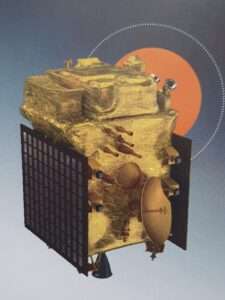Following the success of Chandrayaan 3, the Indian Space Research Organisation (ISRO) is embarking on another groundbreaking venture: the Aditya L1 mission. This ambitious mission aims to study the Sun from up close, unlocking the secrets of our nearest star and advancing our understanding of solar phenomena. With the launch scheduled for August, Aditya L1 promises to be a significant milestone in India’s space exploration journey.

The Indian Space Research Organisation (ISRO) is planning to launch its Aditya L1 mission to study the Sun in August 2023. The mission will be the first of its kind in India, and it will provide valuable insights into the Sun’s atmosphere and its impact on Earth.
The Journey to the Sun
The Aditya L1 mission involves sending a satellite to observe the Sun from a unique vantage point known as the Lagrange Point 1 (L1). Positioned between the Earth and the Sun, this strategic location allows the satellite to maintain a fixed relative position with respect to both celestial bodies, enabling continuous and uninterrupted observations.
Scientific Objectives
The primary scientific objectives of the Aditya L1 mission are as follows:
- Studying the Solar Corona: The mission aims to comprehensively study the solar corona, the outermost layer of the Sun’s atmosphere that extends millions of kilometers into space. Understanding the corona is crucial as it plays a significant role in space weather, impacting satellites and communication systems on Earth.
- Investigating Solar Magnetic Fields: Aditya L1 will examine the Sun’s magnetic fields and their influence on solar activities such as solar flares, prominences, and sunspots. These magnetic phenomena are instrumental in shaping the Sun’s behavior and can have far-reaching implications for space weather and Earth’s climate.
- Probing Solar Eruptions: The mission seeks to analyze solar eruptions, such as solar flares and coronal mass ejections, which release vast amounts of energy and particles into space. These eruptions can disrupt communication networks and power grids on Earth, making their study crucial for space weather forecasting.
- Measuring Solar Ultraviolet Radiation: Aditya L1 will measure ultraviolet radiation from the Sun, providing essential data on the Sun’s energy output and its impact on Earth’s atmosphere. This data is vital for understanding the Sun’s influence on climate change and space weather.
Technological Advancements
The Aditya L1 satellite is equipped with advanced instruments and detectors designed to withstand the harsh conditions near the Sun. These cutting-edge technologies will enable precise measurements and observations, revolutionizing our knowledge of the Sun and its effects on our planet.
Collaboration with International Space Agencies
The Aditya L1 mission is a collaborative effort with various international space agencies, including NASA and the European Space Agency (ESA). The sharing of expertise and resources will enhance the mission’s capabilities and ensure a more comprehensive study of solar phenomena.

Some interesting facts about the Aditya L1 mission:
- The European Space Agency( ESA) has said that it would advance tracking support for ISRO’s Sun Mission Aditya L1.
- ISRO will be transferring up its Aditya L1, a coronagraphy satellite, on a Polar Satellite Launch Vehicle( PSLV) rocket to study the solar atmosphere towards the end of August.
- According to ISRO, the spacecraft will be placed into a halo route around the first Lagrange point, L1, of the Sun- Earth system. The satellite around the L1 point has the major advantage of continuously viewing the Sun without occultation/ declines.
- The Adiyta L1 charge is slated to be a couple of days after ISRO attempts to land on the lunar soil its lander that’s being carried by the Chandrayaan- 3 spacecraft.
- Aditya- L1 is named after the Hindu Sun god and the spacecraft’s unborn home, and L1– the first Lagrange point of the Earth- Sun system. It’ll study a number of parcels, similar as the dynamics and origins of coronal mass ejections.
- The European Space Agency( ESA) has said that it would advance tracking support for ISRO’s Sun Mission Aditya L1. The ESA support to Aditya- L1 will include tracking conditioning from Kourou and Goonhilly. It’ll also include support from the largest of ESA’s antennas– the three 35- metre deep space antennas, located in New Norcia, Australia; Malargue, Argentina; and Cebreros, Spain.
Here are some of the key benefits of the Aditya L1 mission:
- The mission will provide valuable insights into the Sun’s atmosphere and its impact on Earth.
- The mission will help scientists to understand how the Sun’s activity affects Earth’s climate.
- The mission will help scientists to better understand the Sun’s evolution.
Here are some of the challenges that the Aditya L1 mission will face:
- The mission will be launched during a period of high solar activity, which could make it difficult to observe the Sun.
- The mission will be operating in a harsh environment, which could damage the spacecraft’s instruments.
- The mission will be a long-duration mission, which will require the spacecraft to be reliable and well-maintened.
As ISRO prepares for the launch of the Aditya L1 mission, anticipation and excitement are building within the scientific community and space enthusiasts worldwide. This ambitious venture promises to unravel the mysteries of the Sun, advancing our knowledge of space weather and its impact on Earth. With Aditya L1, India is poised to make significant contributions to solar research and reinforce its position as a leading player in the field of space exploration. The Aditya L1 mission is a significant undertaking, and it has the potential to provide valuable insights into the Sun.
